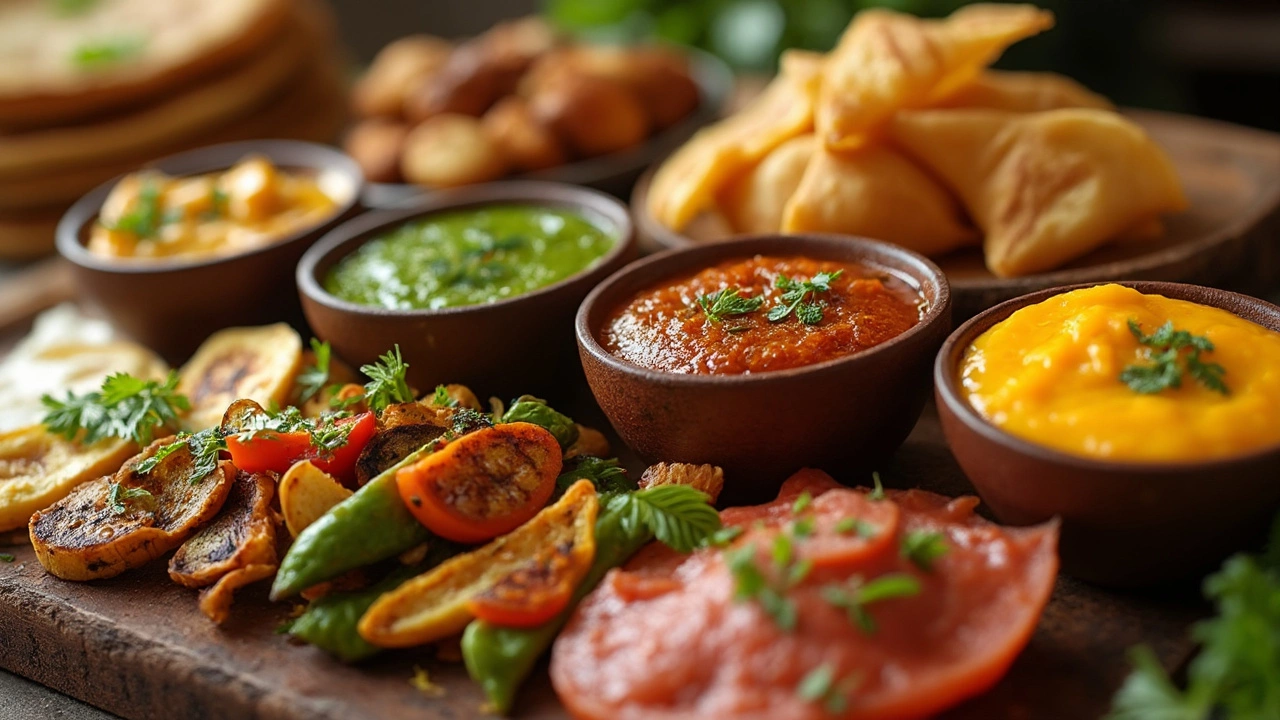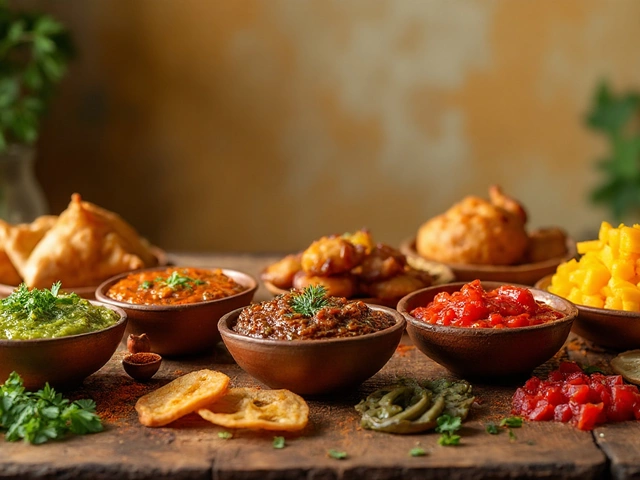If you go to a British grocery store and see jars labeled 'chutney,' you might wonder what exactly you’re looking at. Chutney, as English speakers use it, usually means a thick, flavorful sauce made from fruit, vegetables, sugar, and vinegar — sweet, tangy, or sometimes a little spicy. It’s not quite jam, not quite relish, and nothing like plain ketchup.
The word itself comes straight from India, but chutney in English kitchens has its own spin. Back in the 1700s, the British took a shine to Indian chutneys and started making their own versions. They changed the recipes to fit local tastes—think apples, tomatoes, or even rhubarb, with big helpings of brown sugar and cider vinegar.
Today, you’ll find classic jars like mango chutney on supermarket shelves, perfect for livening up a cheese plate or roast meat. But chutney isn’t just for special occasions or fancy dinners. It’s seriously versatile—spread it in a sandwich, swirl it through rice, or mix it into salad dressings for an instant upgrade. Ever tried chutney on a burger instead of regular sauce? You’re missing out.
- What Does Chutney Mean in English?
- Chutney’s Roots: From India to the English Table
- Common Types of Chutney in English Kitchens
- Simple Ways to Use Chutney with Western Foods
- Homemade Chutney Tips and Recipe Ideas
What Does Chutney Mean in English?
So, what’s chutney in plain old English? It’s a type of condiment or sauce, usually made by cooking down fruits and/or veggies with sugar, vinegar, and spices. The end result is thick, chunky, and loaded with flavor. While it’s got roots in Indian cooking, the English version isn’t always hot and spicy. It’s often more about sweet and tangy, with a little warmth from gentle spices like ginger, cinnamon, or mustard seed.
If you look up chutney in the Oxford English Dictionary, it’ll tell you: “a spicy condiment made of fruits or vegetables with vinegar, spices, and sugar, originating in India.” Pretty straightforward, right? But when English folks talk about chutney, they’re mostly picturing a chunky, spoonable preserves-style sauce. Nothing too runny and nothing too smooth. Mango chutney is everywhere, but apple, tomato, and onion chutneys are big in British homes too.
It’s different from other condiments. Chutney stands out because:
- It balances sweetness, tang, and spices all in one bite.
- It’s usually chunky and not blended smooth.
- You eat it cold or at room temperature, right out the jar.
A lot of people confuse chutney with relish or pickles. Here’s how they really compare:
| Item | Main Ingredients | Texture | Usual Flavor |
|---|---|---|---|
| Chutney | Fruits/veggies, sugar, vinegar, spices | Chunky, thick | Sweet, tangy, spiced |
| Relish | Veggies, vinegar, often no sugar | Finely chopped, saucy | Tangy, sharp, less sweet |
| Pickles | Veggies/fruits, vinegar or brine, spices | Slices or whole | Sour, salty |
Chutney has a rep for being the thing you reach for with cheese, but it does a lot more. Knowing what chutney means helps you figure out how to use it, make it, and pick the right jar for your next meal.
Chutney’s Roots: From India to the English Table
Chutney didn’t start in England—it has a long history in India going back at least 2,000 years. In old Indian Sanskrit texts, people wrote about making pastes and sauces from herbs, spices, and fruit. Those original chutneys were a way to blend spicy, sweet, and tangy flavors and freshen up all kinds of dishes, especially rice and lentils.
Things changed a lot when the British arrived in India in the 1600s. British traders loved the bold flavors and brought recipes back home. But ingredients like mango or tamarind weren’t always around in the UK, so cooks got creative. They started swapping in apples, plums, or even tomatoes, along with vinegar and loads of sugar to make the chutneys last longer in jars.
By the time Queen Victoria was in charge in the 1800s, chutney was on fancy British dinner tables and showing up in cookbooks. The classic British chutney (like fabled Branston Pickle) is chunky, rich, and thick, different from the fresh, sometimes runny versions you’d find at an Indian street stall. Still, the idea is the same: add a hit of flavor to simple foods.
Even now in England, chutney is part of those classic ploughman’s lunches, cheese boards, or holiday spreads. You might see homemade jars swapping hands at local fêtes or community markets. That mix of Indian spice and British invention turned chutney into a kitchen staple both in the UK and in homes everywhere.

Common Types of Chutney in English Kitchens
Walk into an English kitchen, and you’re bound to spot a few classic chutneys sitting right next to the mustard and mayo. Chutney isn’t just a single thing—it’s a whole family of sweet-and-sour spreads with all kinds of flavors and uses. Here’s the rundown on what you’ll usually find in jars around the UK.
- Mango chutney: This is hands down the top pick and the star of the shelf. Made from ripe mangoes, sugar, vinegar, and spices, it brings a punchy balance of sweet and tangy. People love it with curry, but let’s be honest—it goes just as well with grilled cheese or chicken sandwiches.
- Apple chutney: Apples are easy to get in the UK, so this one’s a staple, especially during autumn. It usually has a cozy hit of cinnamon, sometimes raisins or onions, and pairs well with roast pork or cold turkey leftovers.
- Tomato chutney: Think of it as a tangy twist on ketchup, packed with tomatoes, onions, and spices. Spread it on burgers, toss it in salads, or spoon it onto sausages. It’s a crowd-pleaser at summer barbecues.
- Plum chutney: When plums are in season, this slightly tart chutney pops up. It’s often paired with soft cheeses or roast duck, giving meals a richer flavor without loads of effort.
- Onion chutney: Sweet, sticky, and full of caramelized goodness, onion chutney is a hit on cheese boards and burgers. It’s also a sneaky addition to toasted sandwiches for extra flavor.
These chutneys usually pack a decent shelf life thanks to the sugar and vinegar. Most store-bought jars stay fresh for months—easy for busy home cooks.
| Type | Main Ingredients | Common Pairings |
|---|---|---|
| Mango | Mango, vinegar, sugar, spices | Curry, cheese, chicken |
| Apple | Apple, onion, vinegar, cinnamon | Pork, turkey, cheese |
| Tomato | Tomato, onion, spices | Burgers, sausages, salad |
| Plum | Plum, sugar, vinegar | Soft cheese, duck |
| Onion | Onion, sugar, vinegar | Cheese, burgers, sandwiches |
Got an older jar hanging around? Check the lid: as long as it’s sealed and hasn’t gone moldy, it’s probably safe—just give it a sniff first. Homemade chutney recipes have exploded online, but if you’re not ready to make your own, there’s no shame in starting with store-bought. Whatever the type, chutney can jazz up any meal way beyond the usual suspects.
Simple Ways to Use Chutney with Western Foods
If you just bought a jar of chutney and have no clue what to do with it beyond curry, you’re not alone. The good news: it works with way more than just Indian food. In England, it’s actually a common addition to everyday foods, and it can totally upgrade your usual meals.
The simplest way? Swap out your regular spreads. Use chutney instead of ketchup or mayonnaise on a turkey or ham sandwich. That hit of sweet and tangy flavor wakes things up. Try a mild apple or tomato chutney with sharp cheddar in a grilled cheese—it adds a punch you never knew was missing.
Chutney isn’t just for cold foods either. Stir a spoonful into a hot stew or shepherd’s pie for a sweet-savory twist. It also works great as a glaze for roasted meats—mix a bit with olive oil, brush it over chicken, and roast as usual. If you’re grilling burgers, try adding a dollop of chutney right on top instead of relish or BBQ sauce.
- Dip for cheese boards—Branston pickle or mango chutney pairs well with blue cheese or sharp cheddar.
- Quick salad dressing—mix chutney with olive oil and lemon juice for a two-minute dressing.
- Baked brie—spread chutney over a wheel of brie, wrap in pastry, and bake until gooey.
- Leftover booster—stir chutney into plain rice, roasted potatoes, or even scrambled eggs for extra flavor.
In the UK, 4 out of 5 homes keep some kind of chutney or savory pickle around, according to a 2023 survey by Food Network UK. That’s a lot of sandwiches and cheese platters made better with one quick spoonful.
| Western Food | Best Chutney Pairing |
|---|---|
| Grilled Cheese Sandwich | Tomato or Apple Chutney |
| Baked Brie | Mango Chutney |
| Roast Pork | Plum or Rhubarb Chutney |
| Beef Burger | Caramelized Onion Chutney |
Don’t be afraid to get a little experimental—chutney is forgiving. Keep a jar handy and you’ll find yourself reaching for it way more often than you’d expect.

Homemade Chutney Tips and Recipe Ideas
Making chutney at home is a lot easier than it looks, and you can use whatever fruit or veggies you’ve got sitting around. The basics are simple: cut up your main ingredient (like mango, apple, or tomato), add sugar, vinegar, and some spices, and let it bubble away until it thickens. The longer it cooks, the richer the flavor.
If you want your chutney to keep for months, always use clean jars and lids. Let the chutney cool a bit before pouring it in, then close the jars while everything’s still warm. This helps seal in all that goodness.
Here’s something useful—fruit chutneys are usually ready to eat right away, but they taste better if you let them rest a week or so. The flavors blend and mellow out. Try pairing chutneys with things you already eat, like grilled cheese, roast chicken, or even just crackers.
- Choose your main base: Mango is a favorite (especially for beginners), but apples, plums, tomatoes, or even onions work well.
- Don’t skip the sugar and vinegar: This combo preserves the chutney and gives it that sweet-tart punch.
- Get creative with spices: Ginger, mustard seeds, garlic, chili flakes, cinnamon, and cloves are classic, but you can also add cumin or smoked paprika if you want something different.
- Taste as you go: If it’s too sour, add a spoon of sugar. Too sweet? Squeeze in a bit more vinegar.
- Keep things chunky or smooth: Blend part of the chutney if you want it smoother, or just mash it with a fork.
Quick recipe for a basic homemade mango chutney:
- Chop 2 ripe mangos and 1 onion. Toss them into a pot with ½ cup vinegar, 2/3 cup sugar, 1 tablespoon grated ginger, a pinch of salt, and a pinch of chili flakes.
- Bring to a simmer and cook for 40-50 minutes, stirring every now and then so it doesn’t stick. You’ll know it’s ready when it looks thick and glossy.
- Spoon into clean jars and let cool. Done.
If you like things spicy, swap half a bell pepper for a hot chili. If you like chunkier chutney, cut the fruit a little bigger. Once you get the hang of it, you can riff on the basics and make your own signature jar.
Wondering how much sugar and vinegar most recipes need? Check out this handy comparison:
| Chutney Type | Fruit/Veg (cups) | Sugar (cups) | Vinegar (cups) | Cooking Time |
|---|---|---|---|---|
| Mango | 4 | 1 | 1/2 | 45 min |
| Apple | 4 | 3/4 | 1/2 | 40 min |
| Tomato | 4 | 2/3 | 2/3 | 1 hr |
Homemade chutney is a smart way to use up extra fruit. You control the flavors, sugar, and spice. And honestly, fresh chutney tastes way better than anything from a jar.
- Poplular Tags
- chutney
- English meaning
- chutney recipes
- Indian condiments
- how to use chutney











